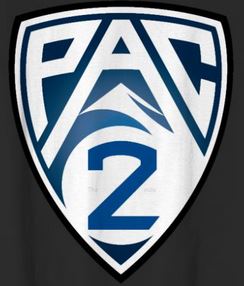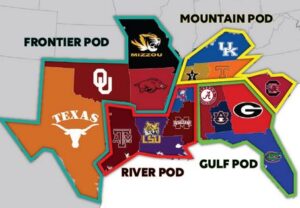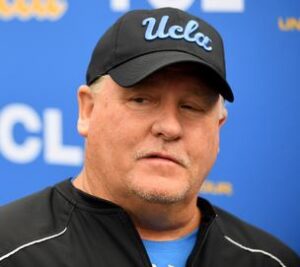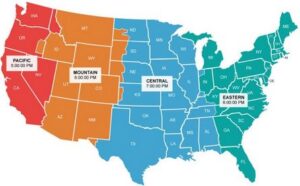Podcast: Play in new window | Download
Subscribe: RSS
Beginning in the fall of 2024, the comfortable regional geography of major college athletic conferences will be no more. Several major college programs have bolted from their long-time conference affiliations in pursuit of more money for their athletic programs.
Sure, the ACC, Big Ten, Big 12, and SEC will still retain the majority of teams from within the traditional geographic footprints of their conferences. The Pac-12 Conference will become the Pac-2 next year with only Oregon State and Washington State remaining in 2024.

Those two West Coast schools have already begun discussions about a potential merger with the nearby Mountain West Conference.
The other “Packed-10” schools in the conference are firing up the corporate jets as they begin a rather illogical eastward migration in 2024.

The Big Ten pilfered USC, UCLA, Oregon, and Washington.
The Big 12 Conference snagged Arizona, Arizona State, Colorado, and Utah beginning next season.
Even the Atlantic Coast Conference got into the act! California and Stanford have just become America’s second and third biggest frequent fliers (behind the Hawaii Rainbow Warriors).
These massive moves by West Coast teams made the SEC’s sneaky minor westward migration into Oklahoma and central Texas in 2024 seem much less noteworthy to geography buffs like me.

Any semblance of common sense in major college athletics in America has nearly evaporated. With tens of millions of dollars being dangled in front of conferences by eager television competitors to seize growing ratings for college football games, the long-time cozy world of stable regional conferences is all but gone starting next year.
As we’ve often heard, there is no “I” in team. It’s a true mad dash to snag the most dollars – by the schools and the players, too. The NCAA’s Transfer Portal and NIL has many top college football and other star players seeking investment advisors as this year comes to a close.
Money talks.

Last week, UCLA head football coach Chip Kelly asked a question which many of us have pondered for a long time.
Why even have athletic conferences for most of the major college football teams anymore?

He said, “I think we should all be independent in football. You can have a 64-team conference that’s in the Power 5 and you can have a 64-team conference in the Group of 5, and we separate it and we play each other.”
Now, you’re talking, Coach Kelly! That makes more sense than what is happening now.
He added, “It’s sad. The fact that there’s not going to be a Pac-12 next year, the fact that Washington State is not going to be [in] a conference next year, the fact that Oregon State is not going to be in a conference next year, we failed.”
In reality, the Pacific Time Zone killed the Pac-12 Conference

The Pac-12 became the poster child for failure to capture enough money in today’s rapidly accelerating world of big money television rights being offered to major college conferences.
Last summer, the Pac-12 Conference concluded a year’s worth of negotiations with anyone and everyone about their future television rights. The best offer came from internet-based Apple TV. It would require Pac-12 viewers to purchase a subscription to Apple TV to watch the games. There would not be an over-the-air option (like CBS, ABC, or Fox) or cable (such as ESPN or CBS Sports Network).
Each Pac-12 school would receive more than $20 million per year in the proposed deal. Unfortunately, that was about half of the annual value which teams in other major conferences will be receiving.
The value disparity isn’t due to America having an anti-West coast bias when it comes to televised sports.

It is because most of America is heading to bed when prime-time football games are kicking off on the West Coast.
While many college football fans might like to see a 7PM Pacific time match-up of Oregon vs. UCLA on a Saturday, that game doesn’t begin until 10PM on the East Coast and 9PM in middle America’s Central time zone. By that time, more than 50% of the US has steadfastly endured up to three straight college football games. A major case of “football fatigue” has settled in across much of the country (ahead of Sunday’s slate of NFL games).
The bottom line is television advertisers get more bang for their bucks as the largest weekly viewing audiences involve the teams located east of the Rockies. Any conference exclusively comprised of teams in the western time zones will be at a competitive disadvantage when television ratings are laid on the table for comparison.
Fewer viewers equal a smaller television contract offer.

When the Pac-12’s proposed new television contract details were revealed, the majority of teams were quite disappointed in the dollar value per team. At that point, ten of the former dozen Pac-12 teams gave a “Good-bye” notice to the Pac-12 this past summer and inked new deals to leave for other conferences.
The ten defectors will come out significantly ahead – at least on the revenue side. .
Did anyone consider how the student-athletes might feel about this?

I doubt that the “labor” at these ten soon-to-be former Pac-12 Conference schools was consulted about how they felt in making such massive geographic moves. Beginning in the fall of 2024, those schools’ student-athletes (in every major sport) will be forced to jet across America to play football, basketball, baseball, volleyball, and other sports to earn money for their respective institutions.
This can’t be a positive for future recruiting at these ten schools.
Why would an elite high school athlete in (for example) Oklahoma want to sign with the University of Southern California and then be required to fly back and forth across the country to play teams in the Midwest and East Coast during football (or basketball, etc.) season? Why not just sign with a top program in your region and play your sport closer to home?
This is where the NIL money creeps in.
This week, it was reported that University of Georgia quarterback Carson Beck has decided to return for his final year of eligibility in Athens. There have been unsubstantiated reports that Beck’s decision to return to Georgia were made easier after the school put together an NIL package valued at about $4 million for the next year.

Here’s the math. If Carson Beck had been eligible for the NFL in 2023, his new $4 million NIL deal equates to the same annual pay as the #16 overall pick received in last spring’s pro football draft.
It makes sense to me that these ten West Coast schools will need to step-up their monetary support for recruits if they expect them to fly back and forth across the country so often beginning in 2024. The student-athletes are now demanding more of the monetary pie.
However, even the NFL and other major sports have tried to keep geography in mind when aligning their teams. Why is college football creating nonsensical geographic landscape for athletics?
Everybody sing along, “Money, money, money, money…!!!”

Speaking of money…
Another thing which UCLA football coach Chip Kelly mentioned last week was paying the players in college football. He suggested a revenue sharing model between the schools and players.
“The players should get paid, and you can get rid of [NIL] and the schools should be paying the players because the players are what the product is,” said Coach Kelly. “And the fact that they don’t get paid is, really, the biggest travesty.”
I don’t share that “travesty” part with Coach Kelly.

Most student-athletes have been provided with a scholarship covering up to 100% of the cost of tuition, room and board. Depending on the school, the cost is substantial.
One source indicated that the total cost of attendance in 2023 (tuition, room, and meals) is now about $28,000 (for public universities) up to $57,000 (private colleges) annually.
If Coach Kelly’s idea to pay all college athletes became a reality, then the cost of attending the institution should be factored into the total compensation paid to each student-athlete.
Then there’s television…

The current major conferences have signed long-term contracts with ESPN, CBS, Fox, NBC and others for the next decade. The parties have made massive financial commitments to one another.
It would take a colossal negotiation between all parties (the 133 FBS schools, the soon-to-be dissolved major conferences, and the primary television networks) to work out an agreeable arrangement for each party.
No one said this would be easy, but let’s put our thinking caps on and give it a try!

The financial outlay surrounding each of the current television deals could be pooled together to determine a total financial value. Each contributing network would then receive a certain number of teams (future draft picks) based on its proportionate value of the current television deals.
For this discussion, let’s say that ESPN received 35% of the teams, Fox received 30%, CBS 20%, and NBC 15%. With 64 teams to be selected, ESPN would receive 22 ping pong balls in the hopper, Fox 19, CBS 13, and NBC 10.
Then, a draft lottery would be held to determine the order of selection by each television partner for those 64 teams in the upper division.
Picture those 64 balls flying around in the air in the hopper with the names ESPN, CBS, Fox, and NBC on them!

Can you imagine the drama surrounding such an event? As each ball is randomly selected, the television partner is allowed one minute to announce the major college football team which the network covets to televise.
The first ball is randomly drawn. Let’s say that CBS has just won the first pick. They must quickly select a college football team to televise all of their home football games for the next “x” number of years.
“With the first pick for home games in the new upper division television rights pool, CBS has selected the University of Alabama!”

This continues for the other 63 selections in the upper division. Talk about must-see TV!
Laugh if you will. Is it any worse than the current college athletics landscape?
Coming up tomorrow, I will utilize Coach Chip Kelly’s concept to create two major college football conferences for the upper division of College Football. You’ll love it, but several football teams in the major conferences won’t.
Stay tuned!

